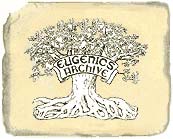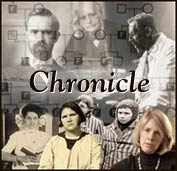












|
Eugenics
Archive grows to 2200+ items
 Browse
950 new photos, papers, and data – including extensive collections
from noted eugenicists. Discover Francis Galton's work on fingerprint
analysis and composite portraiture, and read Charles Davenport's
treatise, Eugenics: The Science of Human Improvement by Better
Breeding, presented in its entirety. Explore Arthur Estabrook's
field photos of subjects of his (in)famous studies: The Jukes
in 1915, Mongrel Virginians, and The Nam Family.
Click the "Search the Archive" button to access the image
database. Browse
950 new photos, papers, and data – including extensive collections
from noted eugenicists. Discover Francis Galton's work on fingerprint
analysis and composite portraiture, and read Charles Davenport's
treatise, Eugenics: The Science of Human Improvement by Better
Breeding, presented in its entirety. Explore Arthur Estabrook's
field photos of subjects of his (in)famous studies: The Jukes
in 1915, Mongrel Virginians, and The Nam Family.
Click the "Search the Archive" button to access the image
database.(New images have ID#s 1255-2320.)  Examine
the Chronicle of how society dealt with mental illness and other
"dysgenic" traits in the final installment of our website:
DNA Interactive.
Meet four individuals who became objects of the eugenic movement's
zeal to cleanse society of "bad" genes during the first
half of the 20th century. Then meet a modern-day heroine for an
account of mental illness and the lesson it holds for living in
the gene age. Examine
the Chronicle of how society dealt with mental illness and other
"dysgenic" traits in the final installment of our website:
DNA Interactive.
Meet four individuals who became objects of the eugenic movement's
zeal to cleanse society of "bad" genes during the first
half of the 20th century. Then meet a modern-day heroine for an
account of mental illness and the lesson it holds for living in
the gene age. |
![]() he
philosopher George Santayana said, "Those who cannot remember the past
are condemned to repeat it." This adage is appropriate to our current
rush into the "gene age," which has striking parallels to the eugenics
movement of the early decades of the 20th century. Eugenics was, quite
literally, an effort to breed better human beings – by encouraging
the reproduction of people with "good" genes and discouraging those with
"bad" genes. Eugenicists effectively lobbied for social legislation to
keep racial and ethnic groups separate, to restrict immigration from southern
and eastern Europe, and to sterilize people considered "genetically unfit."
Elements of the American eugenics movement were models for the Nazis,
whose radical adaptation of eugenics culminated in the Holocaust.
he
philosopher George Santayana said, "Those who cannot remember the past
are condemned to repeat it." This adage is appropriate to our current
rush into the "gene age," which has striking parallels to the eugenics
movement of the early decades of the 20th century. Eugenics was, quite
literally, an effort to breed better human beings – by encouraging
the reproduction of people with "good" genes and discouraging those with
"bad" genes. Eugenicists effectively lobbied for social legislation to
keep racial and ethnic groups separate, to restrict immigration from southern
and eastern Europe, and to sterilize people considered "genetically unfit."
Elements of the American eugenics movement were models for the Nazis,
whose radical adaptation of eugenics culminated in the Holocaust.
We now invite you to experience the unfiltered story of American eugenics – primarily through materials from the Eugenics Record Office at Cold Spring Harbor, which was the center of American eugenics research from 1910-1940. In the Archive you will see numerous reports, articles, charts, and pedigrees that were considered scientific "facts" in their day. It is important to remind yourself that the vast majority of eugenics work has been completely discredited. In the final analysis, the eugenic description of human life reflected political and social prejudices, rather than scientific facts.
You may find some of the language and images in this Archive offensive. Even supposedly "scientific" terms used by eugenicists were often pervaded with prejudice against racial, ethnic, and disabled groups. Some terms have no scientific meaning today. For example, "feeblemindedness" was used as a catch-all for a number of real and supposed mental disabilities, and was a common "diagnosis" used to make members of ethnic and racial minority groups appear inferior. However, we have made no attempt to censor this documentary record – to do so would distort the past and diminish the significance of the lessons to be learned from this material.
During a two-year review process, involving a 14-member Advisory Panel, this site has developed an editorial policy to protect personal privacy and confidentiality. For this reason, names and places have been deleted from pedigrees, medical documents, and personal photographs.
American Philosophical Society Library
Archiv zur Geschichte der Max-Planck-Gesellschaft
Cold Spring Harbor Laboratory Archives
International Center of Photography
National Park Service
Rockefeller Archive Center
Truman State University
University at Albany
University College London
University of Tennessee, Knoxville
University of Virginia
DOLAN
DNA LEARNING CENTER, COLD SPRING HARBOR LABORATORY
1 Bungtown Road, Cold Spring Harbor, New York 11724
